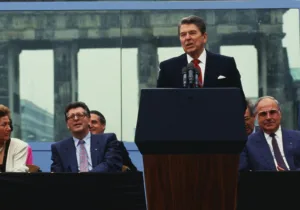China’s one-child policy, enacted from 1980 to 2016, sought to reduce the population growth rate by limiting citizens to one child per family, often resorting to forced abortions, sterilizations, and economic coercion towards this end. Now, policymakers in Beijing face the opposite problem: with China’s plummeting birth rate now becoming an economic threat, the government is trying to backpedal. Unfortunately, the lessons taught by the one-child policy are proving hard for Chinese citizens to forget.
The one-child policy morally reeducated generations of Chinese citizens. While the policy became an official nationwide mandate in 1980, the anti-life posturing of the Chinese government dates back to the very beginning of the People’s Republic. The CCP first began promoting family planning in 1949, fearing rapid population growth would inhibit economic progress and risk reprising previous periods of starvation. Decades later, as voluntary population reduction failed to achieve the results desired, the Chinese Communist Party redoubled its efforts. The late 70s saw the introduction of a voluntary program limiting families to two children, which was reduced to one a year later, and a year later the official one-child policy was born. On September 25th, 1980, the CCP’s Central Committee published a public letter announcing that families were to adhere to the new limit.
The Party’s experiment in reigning in fertility proved more difficult than simply issuing a proclamation, ultimately requiring a wide array of carrots and sticks to achieve compliance across the Chinese population. Efforts were primarily concentrated in urban areas, both because overpopulation there was more problematic and because families in more rural communities were less likely to comply with the mandate. In addition to increasing access to various forms of contraception, the CCP would force abortions and sterilizations on women who already had a child. If women refused, government officials could bulldoze their homes or arrest their family members to pressure them into compliance.
Over time, though, the policy’s effect on the population’s fear of the government and perception of babies meant that abortion and infanticide became a way of life. China’s infanticide epidemic was particularly brutal on female children. Since male children were both socially and economically more valuable, especially in rural areas where they were needed to both work and inherit family farms, it was common for parents to kill or abandon female babies in favor of trying for sons.
It’s become clear that the One Child Policy has backfired in more ways than one. The rapid decrease in population means that China’s population pyramid is “top heavy,” with older generations, especially the 45 to 65-year-old brackets, outnumbering younger ones. As older generations begin exiting the workforce, it’s unclear whether younger generations will be large enough to care for them, both in terms of the number of healthcare workers and the direct care parents typically rely on from children, but also the economy and tax pool more broadly.
The gendered consequences of the one-child policy are similarly problematic. As a result of decades of sex-specific abortion and infanticide, the gender imbalance in the Chinese population is severe, especially for younger generations. With almost 35 million more men than women, many men are finding it difficult to find a wife, never mind having children. These men may also be tough to date. The generation of only-child boys has ended up with long-term behavioral issues, with some analyses finding that the one-child policy “…has produced significantly less trusting, less trustworthy, more risk-averse, less competitive, more pessimistic, and less conscientious individuals.”
Ultimately though, the biggest consequences of the one-child policy aren’t demographic, they’re value-based. Generations of small families, abortion, and infanticide have reduced the value many young Chinese citizens place on babies. Being raised around only children also has made it nearly impossible for young citizens to picture what life looks like with bigger families, and many don’t see the point in having children at all. Those who do would rather spend their time and money on an only child, optimizing for the best schools, care, and resources for a single child.
The “China Family Planning Association,” has now reversed its mission from planning against families to planning for them. But as Beijing tries to change young people’s minds, the central government is quickly learning how hard it is to reverse the trends they put in motion. They do recognize that, at its heart, the issue is cultural. Late last year President Xi Jinping declared that the CCP “…should actively foster a new type of marriage and childbearing culture.” Since 2017, the Chinese government has been testing out policy interventions, offering couples thousands who have more than one child, giving parents longer maternity and paternity leave, making it more difficult to get certain birth control procedures, and even trying to elevate depictions of women with multiple children in propaganda and in school textbooks. Other interventions are more personal, like events offering women free rice cookers for learning about the benefits of bigger families. The government even texted citizens on Valentine’s Day to remind them that it’s better to marry and start families young.
Unfortunately, it’s unlikely they’ll be successful, especially if their neighbors are any indication. South Korea and Japan have both attempted population increase schemes in recent years, everything from tax breaks and economic incentives to childcare investments and PSAs, to little avail.
China is now experiencing an economic slowdown for the first time since the inception of its one-child policy, a trend that seems set to last. If nothing else, other countries should look to China as a case study of the consequences of central planning and anti-life public policy, as well as how durable the pedagogical nature of law is. The public value of life is as essential to a functioning society as it is fragile.






 Sponsor a student for Christianity & National Security 2024
Sponsor a student for Christianity & National Security 2024